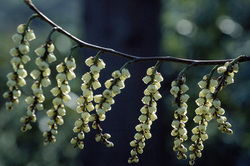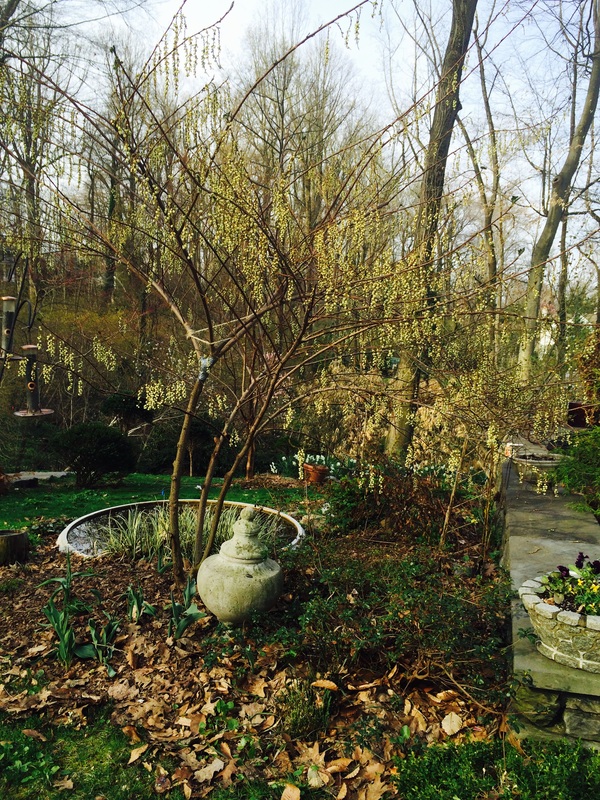
Stachyurus praecox grows well in a mixed shrub border where it has shelter from cold, drying winds. At RHS Garden Hyde Hall it comes into flower in mid spring and complements other spring flowerers such as hellebores very well with its delicate, pendent yellow-green flowers. It can be found growing in the Hilltop Garden in a mixed border.
The Facts
Family: Stachyuraceae
Genus: Stachyurus
Common Name: Spiketail
Area of Origin: Himalayas and Japan
Characteristics: A spreading, deciduous shrub, 3'-12' high by 10' wide that bears oval, mid-green leaves on arching, reddish-purple shoots. It is grown for is hanging spikes of tiny, bell-shaped, pale yellowish-green flowers that appear on bare stems in late winter and early spring. They look like yellow catkins, and are up to 10cm (4in) long. It grows on the Japanese mountains, and its Japanese name Kibusi, comes from the fact that the seed is used for black dye. The plant offers some autumnal colour as the leaves turn a gold and reddish hue. It makes a lovely plant for a woodland garden, and is suitable in any shrub border. It can also be trained against a wall. Great underplanted with hellebores for an early spring display
This is a genus of about 10 species of deciduous or semi-evergreen shrubs, and occasionally small trees. They are native to woodlands and thickets in the Himalayas and East Asia. The genus name Stachyurus comes from the Greek, where stachys is a spike and oura is a tail, after the flowers. This is also the origin of the common name, spiketail.
Hardiness: USDA Zones 7 to 9 (though we're 6, hence the very sheltered position).
Cultivation needs: It prefers to grow in moist but well-drained, humus-rich, fertile soil that is neutral to acid. It prefers partial shade but will tolerate full sun if it is kept reliably moist. Provide shelter from cold, drying winds. Pruning is not essential, but if carried out it should be done after flowering, to maintain a healthy framework. Cut out flowered shoots to the base on mature plants. Hard frosts may damage the flower buds.
Typical Pests, Diseases, associated problems: It is generally not susceptible to pests and disease.
Propagation Method: Supposedly by cuttings but I haven't had much luck with this
The Facts
Family: Stachyuraceae
Genus: Stachyurus
Common Name: Spiketail
Area of Origin: Himalayas and Japan
Characteristics: A spreading, deciduous shrub, 3'-12' high by 10' wide that bears oval, mid-green leaves on arching, reddish-purple shoots. It is grown for is hanging spikes of tiny, bell-shaped, pale yellowish-green flowers that appear on bare stems in late winter and early spring. They look like yellow catkins, and are up to 10cm (4in) long. It grows on the Japanese mountains, and its Japanese name Kibusi, comes from the fact that the seed is used for black dye. The plant offers some autumnal colour as the leaves turn a gold and reddish hue. It makes a lovely plant for a woodland garden, and is suitable in any shrub border. It can also be trained against a wall. Great underplanted with hellebores for an early spring display
This is a genus of about 10 species of deciduous or semi-evergreen shrubs, and occasionally small trees. They are native to woodlands and thickets in the Himalayas and East Asia. The genus name Stachyurus comes from the Greek, where stachys is a spike and oura is a tail, after the flowers. This is also the origin of the common name, spiketail.
Hardiness: USDA Zones 7 to 9 (though we're 6, hence the very sheltered position).
Cultivation needs: It prefers to grow in moist but well-drained, humus-rich, fertile soil that is neutral to acid. It prefers partial shade but will tolerate full sun if it is kept reliably moist. Provide shelter from cold, drying winds. Pruning is not essential, but if carried out it should be done after flowering, to maintain a healthy framework. Cut out flowered shoots to the base on mature plants. Hard frosts may damage the flower buds.
Typical Pests, Diseases, associated problems: It is generally not susceptible to pests and disease.
Propagation Method: Supposedly by cuttings but I haven't had much luck with this

 RSS Feed
RSS Feed
